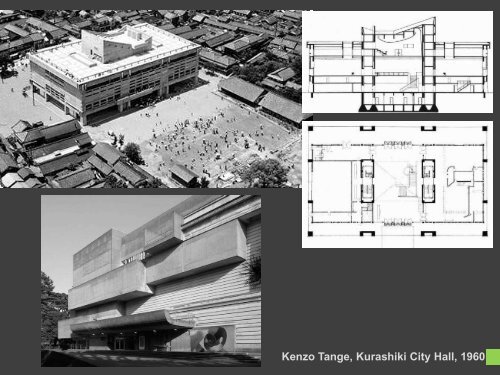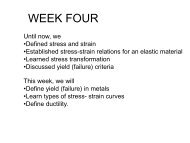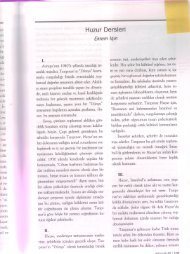Kenzo Tange, Kurashiki City Hall, 1960
Kenzo Tange, Kurashiki City Hall, 1960
Kenzo Tange, Kurashiki City Hall, 1960
You also want an ePaper? Increase the reach of your titles
YUMPU automatically turns print PDFs into web optimized ePapers that Google loves.
Jorn Utzon, Sydney Opera House, 1957-73
Louis Kahn, Kimbell Art Museum, Texas, 1966-72
James Stirling, FloreyBuilding, Queen‟s College, Oxford, 1966-71
Alison-Peter Smithson, Robin Hood Gardens, Londra, 1969-75
Toplu Konut Projeleri, Triviale, İtalya, erken 1970ler
Ticarileşen “cam kutular,” <strong>1960</strong>lar ve sonrası
Alison-Peter Smithson, Golden Lane önerisi, 1952
George Candilis, Alexis Josic, Shadrach Woods,Toulous-le-Mirail, 1961
George Candilis, Alexis Josic, Shadrach Woods, Free University of Berlin, 1964-79
Aldo Van Eyck, Orphanage, Amsterdam, 1957-60, Mat plan
Herman Hertzberger, Central Beheer Office Complex, Hollanda, 1972
<strong>Kenzo</strong> <strong>Tange</strong>, Tokyo Bay Project, <strong>1960</strong>
Kiyonore Kikutake, Cities in the Air, 1959
Arata Isozaki – Joint Core Stem, <strong>1960</strong>
Arata Isozaki – Clusters in the Air project, 1962
Moshe Safdie, Habitat 67, Montreal
Kisho Kurokawa, Nagakin Capsul Tower, Tokyo, 1970-72
Archigram, Plug-in <strong>City</strong>, 1964
Kisho Archigram, Plug-in <strong>City</strong>, 1964
Archigram, A Walking <strong>City</strong>, 1964
Archigram, A Walking <strong>City</strong>, 1964
Constant, New Babylon, 1959-
Natalini wrote in 1971 “…if design is merely aninducement to consume, then we must reject design;if architecture is merely the codifying of bourgeoismodel of ownership and society, then we must rejectarchitecture; if architecture and town planning ismerely the formalization of present unjust socialdivisions, then we must reject town planning and itscities…until all design activities are aimed towardsmeeting primary needs. Until then, design mustdisappear. We can live without architecture…”Superstudio, The Continuous Monument, An Architectural Model For Total Urbanisation, 1969
Robert Venturi, Vanna Venturi House, 1959-1964
Robert Venturi, Vanna Venturi House, 1959-1964
Robert Venturi, Guild House, Philadelphia, 1962-1964
Hanselmann House, Fort Wayne, Indiana1967-68Michael Graves, Benacerraf House, New Jersey, 1969
House IVPeter Eisenmann, House II, 1969
House VI, Fourteen Transformations(axonometric), Cornwall, ConnecticutPeter Eisenman, MOMAPeter Eisenmann, House VI, 1972-75
The Demolition of the Pruitt-Igoe Building."Happily, it is possible to date the death of ModernArchitecture to a precise moment in time." Charles Jenks.After months of preparation, the first building was demolishedat 3 p.m., on March 16, 1972. The second one went downApril 22, 1972. The first stage of demolition completed on July15.Pruitt-Igoe was a large urban housing project in St. Louis,Missouri.Built 1954-5Architect - Minoru Yamasaki, who also designed the WorldTrade Centre, New York.Architectural Forum praised the layout as "verticalneighborhoods for poor people"Each row of buildings was supposed to be flanked by a "riverof trees"By 1968 the authorities were encouraging people to leave.By 1971 it was calculated that the estate had cost $57 millionyet had never been more than 60% occupied.By late 60s it was notorious: extreme poverty, crime, andsegregation.32 buildings were demolished in total from1972-4.Post-modernizm?
Post-modernizm?
The Demolition of the Pruitt-Igoe Building."Happily, it is possible to date the death of Modern Architecture to a precise moment in time." Charles Jenks.After months of preparation, the first building was demolished at 3 p.m., on March 16, 1972. The second onewent down April 22, 1972. The first stage of demolition completed on July 15.Pruitt-Igoe was a large urban housing project in St. Louis, Missouri.Built 1954-5Architect - Minoru Yamasaki, who also designed the World Trade Centre, New York.Architectural Forum praised the layout as "vertical neighborhoods for poor people"Each row of buildings was supposed to be flanked by a "river of trees"By 1968 the authorities were encouraging people to leave.By 1971 it was calculated that the estate had cost $57 million yet had never been more than 60% occupied.By late 60s it was notorious: extreme poverty, crime, and segregation.Pruitt-Igoe Bloklarının Yıkımı, 197232 buildings were demolished in total from1972-4.
The Byker housing forms a wall to protect the residents from thenoise of a busy road situated along the edge of the site (seefigure 4.6). The windows are small and the walls are high toreduce the amount of noise which is allowed to penetrate into theapartments, communal path ways and green areas. Within thiswall the individual apartments form a complex pattern. Thearrangement of the communal areas and housing is similar toVan Eyck‟s „Nagele village‟. There are a number of open greenareas which form focal points for the corresponding housing. Inconsistency with Van Eyck‟s ideas, Eskine uses the internalwalkways, galleries and bridges to visually and figurativelyconnect with the open spaces.Ralph Erskine, Byker Wall Konutları, Newcastle, 1969-75
Ralph Erskine, Byker Wall Konutları, Newcastle, 1969-75
Aldo Rossi, Gallaratese Konutları, Milano, 1969-76
Aldo Rossi, Gallaratese Konutları, Milano, 1969-76
Aldo Rossi, Gallaratese Konutları, Milano, 1969-76
Giorgio de Chirico, Mystère etmélancolie d'une rue, 1914Ariadne, 1913Giorgio de Chirico, Kuzey İtalya arkadları, kent, tarih ve melankoli
Alvaro Siza, Quinta da Malagueira Konutları, Evora, Portekiz, 1977-99
Alvaro Siza, Quinta da Malagueira Konutları, Evora, Portekiz, 1977-99
Norman Foster, Willis Faber Dumas Building, Ipswich, İngiltere, 1975
Architectural Review, June 1975Norman Foster, Willis Faber Dumas Building, Ipswich, İngiltere, 1975
Herman Hertzberger, Centraal Beheer Ofis Binası, Apeldoorn, 1972
Herman Hertzberger, Centraal Beheer Ofis Binası, Apeldoorn, 1972
SOM, John Hancock Center, Chicago, 1968-70Minoru Yamasaki, World Trade Center, New York, 196970‟lerin başında Highrise, Yüksek yapılar / gökdelenler
Hugh StubbinsCiticorp HeadquartersNew York 1978Phillip Johnson, AT&T BuildingNew York, 197970‟lerin sonunda Highrise, Yüksek yapılar / gökdelenler
Richard Rogers, Renzo Piano, Centre National d'Art et Culture Georges Pompidou, Paris1971-77
Richard Rogers, Renzo Piano, Centre National d'Art et Culture Georges Pompidou, Paris1971-77
Richard Rogers, Renzo Piano, Centre National d'Art et Culture Georges Pompidou, Paris1971-77
Louis Kahn, Kimbell Sanat Merkezi, 1966-72
Louis Kahn, Kimbell Sanat Merkezi, 1966-72
Michael Graves, Piazza d‟Italia, New Orleans, 1975-79
Bernard Tschumi, Parc de la Villette, Paris, Yarışma: 1982/3, Uygulama: 1984-87
Starchitect-ure
Digital fabrications
Geri dönüşüm ve sürdürülebilir mimarlık
Johann Otto Von Spreckelsen, Grande Arche de la Défense, Paris, 1983-9
Malka bu tasarımı terk edilmişler, marjinalleştirilmişler, mülteciler,göstericiler, muhalifler, hippiler, ütopyacılar ve tüm türdenuyruksuzları birleştirme çabasını ortaya koyuyor. Bu konsepttasarımı Malka, göz ardı edilen kamusal alanların, prefabrik vegasp yoluyla inşaat sistemleri ile kentsel sınırlamalara direnişolarak kullanılıp kullanılamayacağını araştırıyor.Johann Otto Von Spreckelsen, Grande Arche de la Défense, Paris, 1983-9Staphane Malka, “Auto-defense”
















